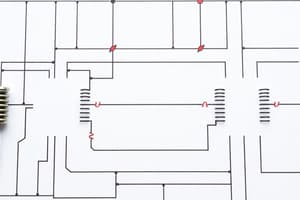Podcast
Questions and Answers
What is the unit of measurement for current?
What is the unit of measurement for current?
- Amp (correct)
- Joule
- Volt
- Ohm
A longer wire has less resistance than a shorter wire of the same material and cross-sectional area.
A longer wire has less resistance than a shorter wire of the same material and cross-sectional area.
False (B)
What is the relationship between voltage, current, and resistance, as described by Ohm's Law?
What is the relationship between voltage, current, and resistance, as described by Ohm's Law?
Ohm's Law states that voltage (V) is directly proportional to current (I) and resistance (R). This can be represented by the equation V = I * R.
The ______ is the difference in electric potential between the two terminals of a resistor.
The ______ is the difference in electric potential between the two terminals of a resistor.
Match the following terms with their corresponding definitions:
Match the following terms with their corresponding definitions:
Flashcards
Ohm's Law
Ohm's Law
It describes the relationship between voltage, current, and resistance in a circuit.
Kirchhoff's Voltage Law
Kirchhoff's Voltage Law
It states that the sum of all the voltages around a closed loop in a circuit is zero.
Series Circuit
Series Circuit
It determines the relationship between voltage, current, and resistance in a series circuit.
Parallel Circuit
Parallel Circuit
Signup and view all the flashcards
Kirchhoff's Current Law
Kirchhoff's Current Law
Signup and view all the flashcards
Resistance
Resistance
Signup and view all the flashcards
Current
Current
Signup and view all the flashcards
Voltage
Voltage
Signup and view all the flashcards
What is Voltage?
What is Voltage?
Signup and view all the flashcards
What is Current?
What is Current?
Signup and view all the flashcards
What is Resistance?
What is Resistance?
Signup and view all the flashcards
What is Ohm's Law?
What is Ohm's Law?
Signup and view all the flashcards
Problem 1: Current Flow
Problem 1: Current Flow
Signup and view all the flashcards
Problem 2: Battery Voltage
Problem 2: Battery Voltage
Signup and view all the flashcards
Problem 3: Hairdryer Resistance
Problem 3: Hairdryer Resistance
Signup and view all the flashcards
Study Notes
Ohm's Law
- Ohm's law describes the relationship between voltage, current, and resistance
- The formula for Ohm's law is V = I * R, where V is voltage, I is current, and R is resistance
- Voltage and current are proportional to each other, meaning that if one increases, the other increases as well, assuming resistance stays constant
- Resistance and current are inversely proportional to each other, meaning that if one increases, the current decreases, assuming voltage stays constant
- Voltage is the electric potential energy difference per unit charge, measured in volts. One volt equals one joule of electric potential energy per coulomb of charge. Electrons have more energy at higher voltages
- Current represents the flow of electrons, measured in amperes. One ampere equals one coulomb of charge flowing per second. Current is comparable to the rate of water flow through a pipe.
- Resistance opposes the flow of current, measured in ohms. A longer wire has more resistance than a shorter wire because electrons have a longer distance to travel. A thinner wire has more resistance than a thicker wire due to a more constricted flow path.
- Conventional current flow is often considered the flow of positive charge, the opposite direction of electron flow.
- The voltage across a resistor is the difference in electric potential between the two terminals, independent of the positive/negative reference.
Series Circuits
- In a series circuit, resistors are connected in a single path, so the current flowing through each resistor is the same
- To find the total resistance of a series circuit, add the values of all the resistors
- The voltage across each resistor in a series circuit can be calculated using V = I * R
- Kirchhoff's voltage law states that the sum of all the voltages around a closed loop in a circuit is zero
- In a circuit loop, the battery's potential difference is positive, providing energy to the circuit, while resistors dissipate energy as heat and have negative values
Parallel Circuits
- In a parallel circuit, resistors are connected across multiple paths, so the voltage across each resistor is the same
- The total current leaving the battery in a parallel circuit is equal to the sum of the individual currents flowing through each resistor
- Kirchhoff's current law states that the total current entering a junction is equal to the total current leaving the junction
- The current through each resistor in a parallel circuit can be calculated using V = I * R
- As resistance increases, the current decreases in a parallel circuit, provided that the voltage is held constant
- The relationships between voltage, current, and resistance can be seen in both series and parallel circuits
Key Equations
- V = I * R (Ohm's Law)
- I = Q/T (Current is equal to charge divided by time)
Practice Problems
- A 12 Volt battery is connected across a 4 Ohm resistor. Calculate the current flow in the circuit. Answer: 3 Amps
- A battery is connected across a light bulb with a resistance of 75 Ohms. The ammeter detects a current flow of 120 milliamps. Calculate the voltage of the battery. Answer: 9 Volts
- A hairdryer draws a current of 0.8 Amps from a 120 Volt power source. Calculate the internal resistance of the hairdryer. Answer: 150 Ohms
Studying That Suits You
Use AI to generate personalized quizzes and flashcards to suit your learning preferences.




